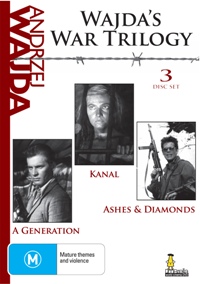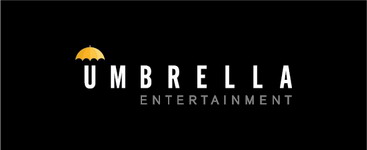Kanal (1957) |
|
Kanal (1957) |
|


|
| BUY IT |
| General | Extras | ||
| Category | Drama |
Interviews-Crew-An Interview with Director Andrzej Wajda Trailer-Open City by Roberto Rosellini Trailer-Closely Observed Trains by Jiri Menzel Trailer-Europa Europa by Agnieszka Holland Trailer-The Tin Drum by Volker Schlöndorff. |
|
| Rating |

|
||
| Year Of Production | 1957 | ||
| Running Time | 91:50 | ||
| RSDL / Flipper | RSDL (84:53) | Cast & Crew | |
| Start Up | Ads Then Menu | ||
| Region Coding | 4 | Directed By | Andrzej Wajda |
|
Studio
Distributor |
 Umbrella Entertainment |
Starring |
Teresa Izewska Tadeusz Janczar Wienczyslaw Glinski Tadeusz Gwiazdowski Stanislaw Mikulski Emil Karewicz Vladek Sheybal Teresa Berezowska |
| Case | Amaray-Transparent-S/C-Dual | ||
| RPI | Box | Music | Adam Pawlikowski |
| Video | Audio | ||
| Pan & Scan/Full Frame | Full Frame | Polish Dolby Digital 2.0 mono (192Kb/s) | |
| Widescreen Aspect Ratio | None | ||
| 16x9 Enhancement | No | ||
| Video Format | 576i (PAL) | ||
| Original Aspect Ratio | 1.33:1 | Miscellaneous | |
| Jacket Pictures | No | ||
| Subtitles | English | Smoking | Yes |
| Annoying Product Placement | No | ||
| Action In or After Credits | No | ||
Kanal is the second film in Andrzej Wajda's trilogy of films depicting Polish resistance to German troops in Warsaw during World War II. Starting from 1939 when German troops first invaded Poland until the beginning of 1945 it is estimated that 85% of Warsaw was destroyed. Of 1,350,000 residents of Warsaw at the time, approximately 1,000,000 lost everything. As recently as 5 years ago, the current Polish Government estimated that the material loss suffered due to the German Army was somewhere in the vicinity of $US30 to $US50 billion. The Nazi Germany government, seeking recompense for lost land after World War 1 inflicted much suffering on Poland and its people, 6 million perished, half were Jews.
Andrzej Wajda was able to make this film at a time in Poland's history when the Government allowed greater personal freedoms for its citizens after the death of Joseph Stalin (otherwise it is doubtful that it could have been made). Kanal depicts the determination of Home Army resistance to the German Army. The Home Army began an uprising on August 1, 1944. Their goal was to resist the German Army in time for Soviet troops, who were coming across to fight the Germans, to assist. Alas, it seems that Stalin had a long memory and could not forget the embarrassing defeat of the Russian Red Army to Poland in 1921. The Russians conveniently marched into Warsaw in January, 1945 when it was much too late for the Polish resistance.
The Warsaw Uprising (as it came to be known) lasted 63 days but was finally crushed. The events of the film take place in mid-September 1944 when Lieutenant Zadra has 43 of his troops accounted for, starting from 70. After the introduction of the film, a narrator states that(SPOILER ALERT: highlight with mouse to read) by the end only 3 will survive. The film then shows how the main characters in the troop descend, under orders, into the city sewers to meet other resistance fighters in the middle of Warsaw. During the journey through the sewer system the members of the troop start to dwindle. Michal, the composer and supporter of the resistance, quotes Dante's Inferno when contrasting his situation in the sewers as a "descent into hell". Although we, as the audience, know the final outcome of the protagonists at the beginning of the film, Kanal employs a smart video and audio scheme to support it as a thriller. The video makes good use of shadow and the soundtrack imitates the sharp, syncopated rhythms of late 1940s, early 1950s film noir popular scores.
The overall damage to the print for this film is extensive. White artefacts are prevalent in every scene in the film. There are also issues with the audio, with drop-outs and clicks heard throughout.
The Aspect Ratio is 1:33:1 fullscreen.
The film does contain grain and low level noise, although shadow detail is excellent, especially during the second half of the film after the descent into the sewers.
Kanal was shot in black and white.
As soon as the film starts we witness scratches in the transfer and telecine wobble in the titles. White lines appear at 6:10. There are overwhelmingly excessive scratches after reel change markings at two points in the film, one from 18:40 until 21:00 and the other is from 56:55 to 57:41. White artefacts, which represents dust on the film, is prevalent in every scene. Notable film damage can be seen at 7:22, 7:55, 8:21, 11:13, 16:20, 18:34, 32:02, 37:08, 46:00, 55:01, 60:39, 67:41, 70:13, 76:04, 81:37, 83:43, 84:02, 88:34 and 91:35.
Subtitles are soft and support the black-and-white look of the film, being white in colour, they do not stand out.
The RSDL change occurs at 84:53 in the middle of a scene.
| Sharpness | |
| Shadow Detail | |
| Colour | |
| Grain/Pixelization | |
| Film-To-Video Artefacts | |
| Film Artefacts | |
| Overall |
The audio soundtrack to the film is also damaged.
The only audio option is a Polish Dolby Digital Mono soundtrack encoded for 192 kbps.
Dialogue is clear and easy to understand, however I have a feeling that this film was subjected to post-dub synchronisation as sometimes character dialogue does not match the images on screen. Audio drop-outs or clicks can be heard at 0:20, 7:55, 9:08, 9:18, 18:40, 37:18, 37:23, 38:00, 46:30, 59:08, 61:02, 75:43 and 90:54.
The music soundtrack heightens the drama of not knowing what is about to happen next. It has been done in the style of 1940s/1950s film noir thrillers.
There is no Surround Channel Usage as the soundtrack was recorded in Mono.
The Subwoofer is also not utilised.
| Dialogue | |
| Audio Sync | |
| Clicks/Pops/Dropouts | |
| Surround Channel Use | |
| Subwoofer | |
| Overall |
NOTE: To view non-R4 releases, your equipment needs to be multi-zone compatible and usually also NTSC compatible.
Kanal has been released in Region 2 (United Kingdom) and Region 1 (USA).
The Region 2 UK release is identical to the Region 4 release.
The Region 1 Criterion US release has a transfer that could still do with more restoration work but does not contain anywhere near as many artefacts as the Region 2 and Region 4 release. It contains the following extras:
*Andrzej Wajda: On Kanal, a 27-minute exclusive new interview with the director, assistant director Janusz Morgenstern, and film critic Jerzy Plazewski (27:28) 16x9 enhanced.
*Jan Nowak-Jezioranski: Courier from Warsaw, a new 28-minute interview by Wajda of a Warsaw Uprising insider (27:29)
*Behind-the-scenes production photos, publicity stills, posters and an essay by film critic John Simon.
There is also a Region 1 release of Kanal by the distributor Facets, but this version is VHS quality and is to be avoided.
Again, similarly to the first film in the War trilogy boxset, The Region 1 Criterion release has a better transfer and extras than the Region 2 and Region 4 releases.
Kanal had the honour of sharing the Special Jury Prize at the 1957 Cannes Festival with Ingmar Bergman's The Seventh Seal. Like The Seventh Seal, it is a great film, an important part of cinematic history. Both films share the similar theme of mortality and both share a timeless niche in world cinema because of it (unlike Friendly Persuasion by William Wyler which took out the Palme d'Or. Remember that film?) Kanal represents a movement away from Italian Neo-realism and towards the American cinema of film noir genre-themed films in it's style and look, albeit transposed to a war situation. Some film scholars contend that Kanal was the beginning of the Polish Film School movement.
Unfortunately, the transfer of this film leaves a lot to be desired. It really requires a thorough frame-by-frame restoration. The Region 1 Criterion version has a better quality transfer and with it's extras represents the best version of this film available currently on DVD.
| Video | |
| Audio | |
| Extras | |
| Plot | |
| Overall |
| Review Equipment | |
| DVD | Sony BDP-S550, using HDMI output |
| Display | Samsung LA46A650 46 Inch LCD TV Series 6 FullHD 1080P 100Hz. Calibrated with THX Optimizer. This display device is 16x9 capable. |
| Audio Decoder | Sony STR-K1000P. Calibrated with THX Optimizer. |
| Amplification | Sony HTDDW1000 |
| Speakers | Sony 6.2 Surround (Left, Front, Right, Surround Left, Surround Back, Surround Right, 2 subwoofers) |